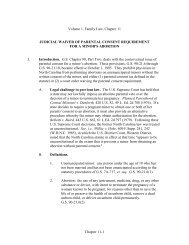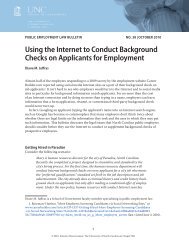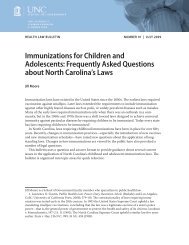Sentencing, Corrections, Prisons, and Jails - School of Government ...
Sentencing, Corrections, Prisons, and Jails - School of Government ...
Sentencing, Corrections, Prisons, and Jails - School of Government ...
Create successful ePaper yourself
Turn your PDF publications into a flip-book with our unique Google optimized e-Paper software.
<strong>Sentencing</strong>, <strong>Corrections</strong>, <strong>Prisons</strong>, <strong>and</strong> <strong>Jails</strong> 231<br />
approximately thirty-five days <strong>of</strong> residential treatment followed by eight weeks <strong>of</strong> aftercare <strong>and</strong> then<br />
participate in Alcoholics Anonymous or Narcotics Anonymous meetings. The private programs last<br />
from three to twelve months <strong>and</strong> treat minimum security inmates at the end <strong>of</strong> their sentences. In 1996,<br />
more than 7,700 inmates were admitted to these programs.<br />
Section 17.12 <strong>of</strong> S.L. 1998-212 (S 1366) provides that $467,806 <strong>of</strong> unspent funds that S.L. 1997-<br />
443 appropriated to DOC for 1997–98 for DART/DWI aftercare at Cherry Hospital do not revert to the<br />
General Fund but remain available to DOC as the legislation specifies. DOC may use $319,715 for the<br />
DART/DWI aftercare program. Also, DOC may use $125,000 for contractual services for the substance<br />
abuse program to identify the information that should be collected to track <strong>of</strong>fenders <strong>and</strong> evaluate the<br />
program, <strong>and</strong> to train staff to use the tracking <strong>and</strong> evaluation system. The legislation places another<br />
$100,000 in a reserve to purchase hardware <strong>and</strong> s<strong>of</strong>tware for <strong>of</strong>fender tracking <strong>and</strong> program evaluation.<br />
DOC must report by December 15, 1998, to the chairs <strong>of</strong> the Senate <strong>and</strong> House Appropriations<br />
Committees <strong>and</strong> the chairs <strong>of</strong> the Senate <strong>and</strong> House Appropriations Subcommittees on Justice <strong>and</strong><br />
Public Safety concerning its progress in finding consultants to develop a plan for an <strong>of</strong>fender-tracking<br />
<strong>and</strong> program evaluation system. The reserve funds may not be spent until DOC has submitted a plan<br />
for the system to these committees. If the plan is not submitted by March 15, 1999, the General<br />
Assembly will allocate the funds.<br />
Section 17.12 <strong>of</strong> S.L. 1998-212 also requires DOC to report annually by March 1 to these same<br />
committees on its efforts to provide effective treatment to <strong>of</strong>fenders with substance abuse problems. The<br />
report must include, among other things, information on the number <strong>of</strong> current inmates with substance<br />
abuse problems, the number receiving treatment, <strong>and</strong> the number who have completed treatment. As<br />
the <strong>of</strong>fender-tracking system becomes available, the report must also include information on the<br />
recidivism <strong>of</strong> former inmates who complete substance abuse treatment while in prison.<br />
Probation, Parole, <strong>and</strong> Post-Release Supervision<br />
Probation is a status imposed as a sentence in which a criminal <strong>of</strong>fender is subject to a term <strong>of</strong><br />
imprisonment that is suspended on conditions set by the sentencing court. Parole (under the law<br />
preceding the Structured <strong>Sentencing</strong> Act) <strong>and</strong> supervised release (under the SSA) are forms <strong>of</strong> release<br />
from prison, subject to conditions set by the Post-Release Supervision <strong>and</strong> Parole Commission. An<br />
<strong>of</strong>fender’s status <strong>of</strong> being on probation, parole, or supervised release may be revoked, <strong>and</strong> the <strong>of</strong>fender<br />
sent to prison, if the <strong>of</strong>fender commits either new crimes or “technical” (noncriminal) violations <strong>of</strong><br />
conditions, such as payment <strong>of</strong> restitution or participation in a rehabilitative program. Probationers <strong>and</strong><br />
parolees are supervised by <strong>of</strong>ficers <strong>of</strong> the Division <strong>of</strong> Adult Probation <strong>and</strong> Parole (DAPP) <strong>of</strong> DOC. In<br />
1996–97, according to DOC, 58,460 <strong>of</strong>fenders began serving probation sentences <strong>and</strong> 106,492 were on<br />
probation at the end <strong>of</strong> the year (including some whose probation began in earlier years). The number<br />
on parole has been declining since the SSA abolished parole, from a peak <strong>of</strong> 20,879 in 1994–95 to<br />
10,617 by June 1997. (Many <strong>of</strong>fenders still in prison whose crimes occurred before October 1, 1994,<br />
when the SSA went into effect remain eligible for consideration for parole. Also, <strong>of</strong>fenders sentenced<br />
for impaired driving, not covered by the SSA, remain eligible for parole.)<br />
Performance Audit <strong>of</strong> Probation <strong>and</strong> Parole<br />
Section 17.16 <strong>of</strong> S.L. 1998-212 (S 1366) requires DAPP to report by January 1, 1999, on actions<br />
taken or planned in response to the June 1998 report by the State Auditor. The report must be made to<br />
the chairs <strong>of</strong> the Senate <strong>and</strong> House Appropriations Subcommittees on Justice <strong>and</strong> Public Safety <strong>and</strong> the<br />
General Assembly’s Fiscal Research Division.<br />
The auditor’s report was made pursuant to legislation (S.L. 1997-443, sec. 19.13) that called for a<br />
performance audit <strong>of</strong> DAPP addressing its structure, staffing patterns, workload, personnel practices,<br />
<strong>and</strong> general effectiveness. The full text <strong>of</strong> the report is available on the State Auditor’s Internet home<br />
page, http://www.osa.state.nc.us. The following are some highlights <strong>of</strong> the audit <strong>of</strong> DAPP.













